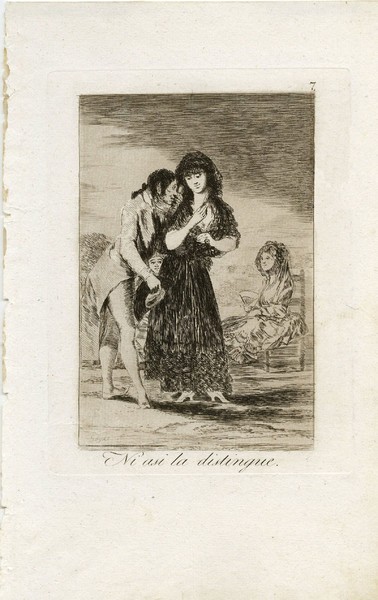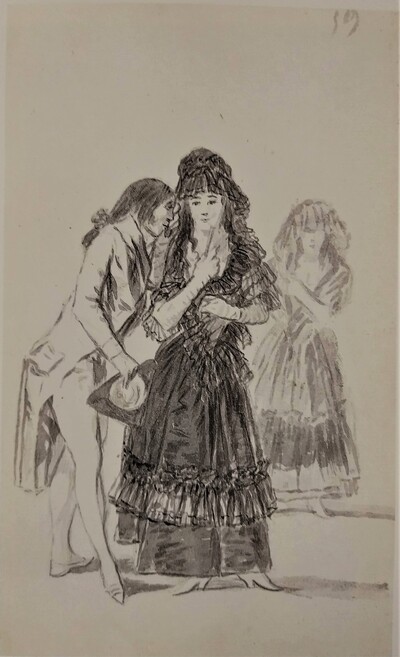- Cronología
- Ca. 1797 - 1798
- Dimensiones
- 200 x 150 mm
- Técnica y soporte
- Aguafuerte, aguatinta y punta seca
- Reconocimiento de la autoría de Goya
- Undisputed work
- Ficha: realización/revisión
- 17 Nov 2010 / 20 Jun 2023
- Inventario
- 225
Ni así la distingue (at the bottom)
7 (in the upper right-hand corner)
Goya (signed in the lower left-hand corner)
See Francisco de Goya y Lucientes, Painter.
There is a state proof to which aquatint and drypoint have already been applied and on which it is written by hand, I can already perceive it. There is also a second state proof in which the definitive title of the engraving is written.
This print was preceded by two preparatory drawings in the Prado Museum. The first is a wash in Indian ink belonging to Album B and the second is a wash in Indian ink.
A maja dressed in black is being courted by a man standing next to her who approaches her and looks at her with a monocle. His posture and the expression on his face suggest his libidinous intentions as well as his somewhat incautious nature. Further back, seated in a chair, a woman can be seen holding a fan in one of her hands and gazing at her with an absorbed air. In the space between the man and the female figure, at waist level, a face appears, attentively observing the scene. The scene could be taking place in the open air; using aquatint, Goya has captured the sky in which a cloud hovers in the upper right corner of the print. He has also depicted the dark clothes of the maja with a profuse use of etching, which contrasts with the man's light clothes.
Ayala's manuscript states that this engraving represents that "to know what is, the eyeglass is not enough, judgement is needed". In the Prado Museum's manuscript it is noted that "How is she to be distinguished? To know what she is, the eyeglass is not enough, it needs judgement and practice of the world, and this is precisely what the poor gentleman lacks". Finally, the manuscript in the National Library indicates that "lustful men are so blinded that even with a lens they cannot distinguish that the lady they are giving as a gift is a harlot".
As in other engravings in this series, Goya makes a veiled allusion to prostitution and in this case also refers to the naivety of some men who are unable to distinguish when they are in the presence of a prostitute and when they are not. He courts her without realising that the woman's interest in the relationship is purely economic. The scene is being watched by an old woman in the background of the engraving who, in all likelihood, could be the procuress.
It is possible that one of the visual sources to which Goya may have had recourse for the characterisation of the types was Les Incroyables, which Louis Darcis engraved between 1796 and 1797 based on the work of Carle Vernet (Bordeaux, 1758-Paris, 1835). He may also have been familiar with an anonymous engraving produced in the late 18th century entitled The Petimetra in the Prado in Madrid (Madrid City Hall), of which the Aragonese painter may have made a distorted and critical version.
The plate is preserved in the National Chalcography (no. 178).
-
Goya. Gemälde Zeichnungen. Graphik. TapisserienKunsthalle BaselBasle1953from January 23th to April 12th 1953cat. 199
-
Goya. Das Zeitalter der Revolucionen. Kunst um 1800 (1980 – 1981)Hamburger KunsthalleHamburg1980cat. 44
-
Goya y el espíritu de la IlustraciónMuseo Nacional del PradoMadrid1988from October 6th to December 18th 1988. Exhibited also at Museum of Fine Arts, Boston, January 18th to March 26th 1989; The Metropolitan Museum of Art, Nueva York, May 9th to July 16th 1989, Madrid curator Manuela B. Mena Marqués, scientific directors Alfonso E. Pérez Sánchez and Eleanor A. Sayrecat. 42
-
Goya. La década de Los CaprichosMadrid1992organized by Real Academia de Bellas Artes de San Fernando sponsored by Fundación Central Hispano, Madrid, consultant editor Nigel Glendinnig. From October 26th 1992 to January 10th 1993cat. 13
-
Francisco de GoyaMuseo d'Arte ModernaLugano1996exhibition celebrated from September 22nd to November 17th.cat. 7, p.34
-
Ydioma universal: Goya en la Biblioteca NacionalBiblioteca NacionalMadrid1996from September 19th to December 15th 1996cat. 128
-
Francisco Goya. Sein leben im spiegel der graphik. Fuendetodos 1746-1828 Bordeaux. 1746-1996Galerie KornfeldBern1996from November 21st 1996 to January 1997cat. 13
-
Goya artista de su tiempo y Goya artista únicoThe National Museum of Western ArtTokyo1999from December 1st to July 3th 1999cat. 96
-
Francisco Goya. Capricci, follie e disastri della guerraSan Donato Milanese2000Opere grafiche della Fondazione Antonio Mazzottacat. 7, p.18
-
Goya. La imagen de la mujerMuseo Nacional del PradoMadrid2001from October 30th 2001 to February 10th 2002. Exhibitied also at the National Gallery of Art, Washington, March 10th to June 2nd 2002, consultant editor Francisco Calvo Serrallercat. 90
-
Goya e la tradizione italianaFondazione Magnani RoccaMamiano di Traversetolo (Parma)2006consultant editors Fred Licht and Simona Tosini Pizzetti. From September 9th to December 3th 2006cat. 7, p.147
-
Goya. Opera graficaPinacoteca del Castello di San GiorgioLegnano2006exhibition celebrated from December 16th 2006 to April 1st 2007p.23
-
Goya et la modernitéPinacothèque de ParisParís2013from October 11st 2013 to March 16th 2014cat. 178
-
Agen2019cat. 55
-
2022
-
Goya engravings and lithographs, vol. I y II.Bibliography']['numberOxfordBruno Cassirer1964p.77, cat. 42
-
Vie et ouvre de Francisco de GoyaBibliography']['numberParísOffice du livre1970p.177, cat. 463
-
El mundo de Goya en sus dibujosBibliography']['numberMadridUrbión1979pp. 25-26
-
Goya, la década de los caprichos: dibujos y aguafuertesBibliography']['numberMadridReal Academia de Bellas Artes de San Fernando1992p.156, cat. 128
-
Catálogo de las estampas de Goya en la Biblioteca NacionalBibliography']['numberMadridMinisterio de Educación y Cultura, Biblioteca Nacional1996p.156, cat. 128
-
El libro de los caprichos: dos siglos de interpretaciones (1799-1999). Catálogo de los dibujos, pruebas de estado, láminas de cobre y estampas de la primera ediciónBibliography']['numberMadridMuseo Nacional del Prado1999pp.84-87
-
Goya en tiempos de guerraBibliography']['numberMadridMuseo Nacional del Prado2008p.33, fig. 8
-
Bibliography']['number
ParísPinacoteca de París2013p. 244
-
Goya. In the Norton Simon MuseumBibliography']['numberPasadenaNorton Simon Museum2016pp. 42-75
-
Bibliography']['number
AgenSnoeck2019p. 90
-
Bibliography']['number
Museo de Bellas Artes de Badajoz y Diputación de Badajoz2022p. 31


